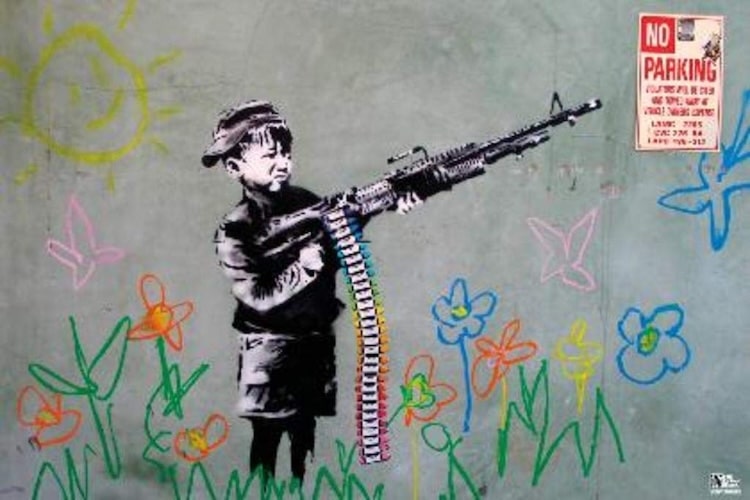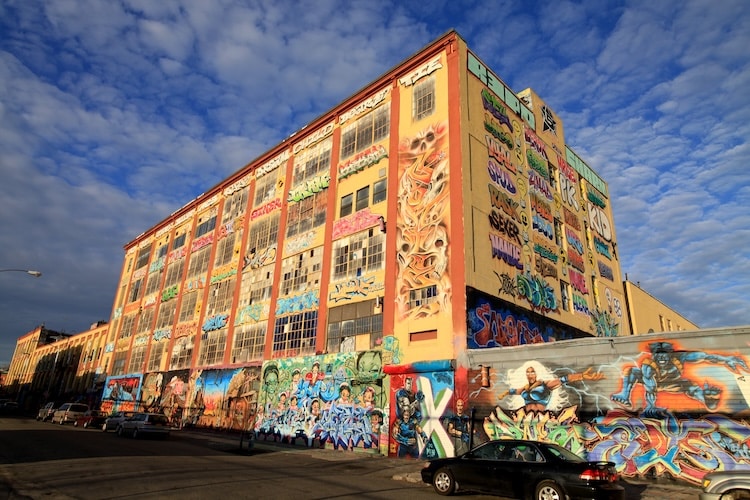Graffiti artists have always been controversial figures. Their work, often associated with stylized lettering and tags, is typically characterized by its focus on personal expression and self-promotion. We have all seen this type of work plastered on public spaces, and because it is often created without permission from the property owners, it is considered illegal vandalism in many jurisdictions. In some areas, especially in lower economic neighborhoods, graffiti art can be pervasive as it also stands as a method of territorial marking for gangs alongside those members of these marginalized communities seeking visibility and empowerment.
During the 1970s and 1980s, New York City’s subway system grappled with a pervasive graffiti problem that not only posed financial burdens but also fueled concerns about safety and disorder. The Metropolitan Transportation Authority (MTA) responded with initiatives like the “Clean Trains Program,” community engagement, and anti-graffiti technologies, eventually mitigating the issue’s impact, revitalizing the subway’s image, and enhancing riders’ experience.
The Ongoing Art vs Vandalism Debate
Despite the potential illegality, many feel that graffiti is still an art form, not simply a mark of defiance and criminality. This debate gained traction with the publication 1974 of Norman Mailer’s The Faith of Graffiti. Mailer explored the intentions of graffiti artists, trying to determine if they were genuinely expressing art or just announcing their presence to the world. Mailer didn’t firmly take sides in the debate but did lean towards portraying graffiti as a legitimate art form. At the time, this perspective was only held by a small minority of the art world, while the majority viewed graffiti as nothing more than vandalism. The battle between these two camps has continued, with graffiti artists having made significant headway in convincing the art world that their work is a proper form of artistic expression.
This debate doesn’t necessarily apply to street artists, who are generally seen in a much better light than graffiti artists. Street art is often far more detailed and artistic than your average graffiti scribble. Where one might associate graffiti with a spray-painted tag or moniker, street art is often far more in-depth. Like graffiti, street art can also be illegal if created without the permission of the property owners. However, because the street art style is more accessible to a wider audience, with traditional and recognizable themes that address political, cultural, or environmental issues, street artists are often able to collaborate with property owners to create their works.

Banksy, “Crayon Boy” (2011)
Street artists like Banksy and Mr. Brainwash have actually made the public salivate with anticipation as they await their next creative exploits. Street art is generally considered an aesthetic enhancement, adding to a neighborhood’s local flavor. However, many street artists lack the authorization to create their pieces, yet they don’t face the same level of criticism as graffiti artists. Banksy is a perfect example. He rarely receives permission for his work, yet despite the illegality, his work is heralded, with numerous books and documentaries focused on his work. The vast majority of property owners would love to wake up one morning and find an original Bansky on their property.
Can Graffiti Artists Legally Protect Their Work?
Generally, art and other creative forms are protected under copyright law, which grants artists or copyright holders exclusive rights to reproduce, distribute, and publicly display their work. Copyright protection is automatic. As soon as an artist creates a work, and as long as it has at least a minimal amount of creativity and originality, it will receive copyright protection. However, there is some legal debate over whether the law typically requires that the work be legally created to qualify for protection. There are some laws in varying jurisdictions that may lean one way or the other. The concept has yet to be codified by Congress or addressed by the Supreme Court, so whether their work can be protected through copyright may still be a problem for graffiti artists.
If the work is not protected by copyright, it means that anyone can make a copy of the work and do whatever they want with it. They can take photos and sell them, put the work on t-shirts for sale at Target, use it in an ad, etc.; however, that only applies to the image of the work. Physical work has broader protection through the Visual Arts Rights Act (VARA).
VARA protects the work of visual artists, including graffiti artists, from intentional distortion, mutilation, or any other form of modification of their work. Under VARA, artworks that meet specific criteria are granted additional rights to their creators, irrespective of subsequent ownership or copyright holders. For example, a painter can insist on proper attribution for their work and, in certain cases, may legally challenge the destruction of their painting, even if the owner lawfully possessed it.
VARA exclusively bestows the following rights upon authors of protected works:
- The right to claim authorship.
- The right to prevent the use of one’s name on any work not created by the author.
- The right to prevent the use of one’s name on any work that has been distorted, mutilated, or modified in a manner detrimental to the author’s reputation.
- The right to prevent distortion, mutilation, or modification that tarnishes the author’s reputation.
- The right to prevent the destruction of a work of recognized stature, with intentional or grossly negligent destruction constituting a violation of this right.
In essence, VARA aims to preserve the integrity of art, and many artists have invoked their VARA rights when their street art was covered or altered. However, it’s important to note that VARA has limitations, and its scope can be narrow. Courts have been divided on whether street artists can claim VARA rights, often emphasizing that the work must be of ‘recognized stature’ to seek protection against destruction. However, two recent cases moved the needle squarely into the hands of the street and graffiti artists.

5Pointz marked a turning point in the world of graffiti art.
5Pointz
5Pointz, located in Long Island City, New York, held a prominent status as the world’s premier “graffiti Mecca.” Artists had been given permission by the property owner to create unique works on the walls of a vast 200,000-square-foot factory since 1993. Over time, 5Pointz evolved into a tourist attraction, drawing hundreds of visitors each week.
In 2013, the artists faced a harsh reality when they discovered that a developer had applied for permits to demolish the building and replace it with luxury apartments. Sixteen artists decided to take legal action to preserve the space under VARA, the Visual Artists Rights Act. However, their initial efforts faced a setback when a New York judge ruled against them. The judge questioned whether street art could be considered art with sufficient stature to warrant protection under VARA.
Despite this setback, a Federal District Court issued a temporary restraining order against the developer, providing a brief respite. Unfortunately, when the restraining order expired, the developer ordered the complete whitewashing of all the artwork. After years of legal battles, justice was finally served in 2018 when Brooklyn Federal Court declared that the developer had violated VARA. The artists won the appeal as well, with the Appeals Court affirming that the developer had whitewashed the artworks without any genuine business need, describing it as an “act of pure pique and revenge” against the artists who had sued him. The court upheld a judgment awarding the artists $6.75 million in damages.
The case eventually made its way to the Supreme Court, but in October 2020, the eight Supreme Court justices declined to hear the appeal, affirming the lower court’s ruling and the $6.75 million award to the artists.
The Ken Twitchell Mural Case
Another noteworthy case followed a more direct path and established a unique precedent in the world of public art. In this instance, artist Ken Twitchell found his mural depicting artist Ed Ruscha unceremoniously whitewashed without his prior consent or even awareness. Fueled by a determination to protect his creative rights, Twitchell pursued legal action, ultimately emerging victorious with a court awarding him a substantial sum exceeding $1 million in damages.
As Ken Twitchell aptly stated, “This settlement sets an important precedent which will benefit other artists.” He emphasized the critical message it sends to both artists and the public at large: in the realm of public art, an artist’s rights must be respected, or those responsible for any unauthorized alteration will face substantial legal liability. This case serves as a resounding reminder of the significance of safeguarding artists’ creative contributions, reinforcing the importance of honoring their rights within the realm of public artistry.
_______
It’s important to understand that while the 5Pointz and Ken Twitchell mural cases have set important precedents in the realm of public art and the protection of artists’ rights, their results are not universally guaranteed in every part of the country. These cases, though significant, have not received the final stamp of approval from the Supreme Court of the United States. As a result, the extent to which these precedents will be upheld across various jurisdictions may vary. While many courts are likely to follow these rulings as guiding principles, the ultimate determination may still hinge on specific circumstances and interpretations of the Visual Artists Rights Act (VARA).
Is Street Art Legal?
In the ongoing debate surrounding graffiti art, the question of whether it can be deemed ‘legal’ remains a concern. In response to the issue, some states or counties have taken proactive measures to provide a framework for graffiti artists to thrive within the bounds of the law. Los Angeles, often at the forefront of intellectual property matters, implemented a murals ordinance that permits graffiti art under certain conditions. They instituted a mechanism for graffiti artists to apply for permits and secure permission from property owners. Notable collaborations, such as the partnership between Shepard Fairey, renowned for his iconic Obama Hope poster and Obey campaign, and graffiti artist Risk, have given rise to significant works in areas like Skid Row.

Skid Row City Limits Mural (2014)
However, it’s important to acknowledge that some artists continue to thrive on the underground and edgy nature of their work, embracing its inherent illegality. Banksy, a prominent figure in this category, has engaged in highly publicized projects, including in New York City, where he created 17 works across various neighborhoods. Banksy’s provocative artistry still attracts the attention of law enforcement agencies, with the NYPD’s vandal squad. Despite the aesthetic admiration for Banksy’s creations, many view him as a vandal and a menace. Former Mayor Bloomberg, for instance, pledged to remove any Banksy works on public property, and he followed through on his promise.
Interestingly, public sentiment often diverges from official stances. Some property owners have hired security guards to protect graffiti art by Banksy, while others have painstakingly removed entire murals and made them available for sale. Banksy’s pieces have fetched millions of dollars on the art market, and they are occasionally detached from walls and auctioned to the highest bidder. In stark contrast to many graffiti artists, Banksy has amassed significant wealth, with his estimated net worth reaching $20 million.
In this ongoing battle for recognition and acceptance, it appears that graffiti art is gradually garnering public support. It may only be a matter of time before the legal landscape and judicial decisions align with this shifting perception, ultimately affirming graffiti art as a legitimate, recognized, and entirely legal form of creative expression. However, the complex interplay between legality and artistic rebellion continues to shape the evolution of graffiti art’s place in society.
What are your thoughts on the evolving status of graffiti art – should it be celebrated as a legitimate art form or condemned as vandalism? Let us know in the comments.
